
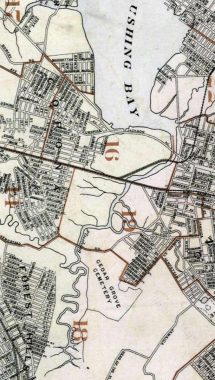
In September 2024 I had to take shorter walks because a chronic sore back condition arose, and my journeys totaled 4 miles or less. Thus things were near “perfect” for me to do a short exploration of Flushing Meadows-Corona Park, which is well worn territory for me; it’s tied with Green-Wood Cemetery for the frequency of Forgotten NY tours there at five. We have toured there in snow and in 92-degree weather, and in 2014, I had a record number of tour participants, at 65. It’s a 10 minute ride on the railroad from FNY headquarters in Little Neck.
During the Covid-19 pandemic, which is still ongoing but whose peak was 2020-2022, a vaccination site was set up at the erstwhile McFadden’s Bar at Citifield, and the MTA began to offer off-season stops at the LIRR Mets-Willets Point station where previously stops were made only for Mets home games and other events. In a rare MTA move I agree with, the Mets-Willets Point stop was made permanent year-round, gaining much easier access to the park. Previously, I de-trained at Flushing Main Street, walked a packed Main Street to Roosevelt Avenue, and rode the #7 one stop.
At left is a 1909 map of Flushing Meadows, when it was nothing but a marshy area bisected by the Flushing River. Only two roads crossed it, Northern Boulevard (in 1909, Jackson Avenue) and Strong’s Causeway, the red line above Cedar Grove Cemetery. Even today, the park serves as an effective barrier between eastern and western Queens, as only Northern Boulevard, Roosevelt Avenue, the Long Island (Horace Harding) Expressway and Jewel Avenue allow through traffic.
In the early 20th Century, the “meadows” became a large ash and rubbish dump. In The Great Gatsby, F. Scott Fitzgerald describes it thus:
About half-way between West Egg and New York the motor road hastily joins the railroad and runs beside it for a quarter of a mile, so as to shrink away from a certain desolate area of land. This is the valley of ashes—a fantastic farm where ashes grow like wheat into ridges and hills and grotesque gardens; where ashes take the forms of houses and chimneys and rising smoke and, finally, with a transcendent effort, of men who move dimly and already crumbling through the powdery air…
The valley of ashes is bounded on one side by a small foul river, and, when the drawbridge is up to let barges through, the passengers on waiting trains can stare at the dismal scene for as long as half an hour…
Spoiler alert!
In the book, Tom Buchanan gets off the stopped train to make his way to the car repair shop (presumably on Northern Boulevard) to meet his mistress, Myrtle, who is later run over by Daisy Buchanan while driving Jay Gatsby’s car. Here, Fitzgerald takes a bit of license as the railroad and Northern Boulevard aren’t really that close to each other.
I’ll admit, I have taken better photos of the Corona Yards (officially MTA New York City Transit Corona Maintenance Facility) serving not only subway cars used on the #7 line from Hudson Yards to Flushing Main Street, but also most bus routes emanating from Flushing and fanning out to points east at the Casey Stengel Bus Depot, named for longtime major league baseball player, coach and manager Casey Stengel but especially for his stint in Flushing managing the woeful Mets in 1964 and part of 1965.
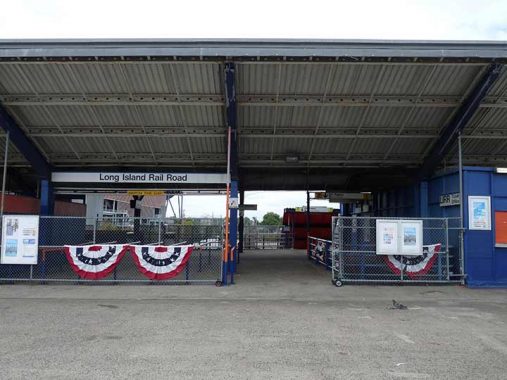
I’ll return to the similarly woeful Mets-Willets Point station later, but for now, let’s just say while I’m happy it’s open year round, I’m disappointed it gets no more care than a fresh coat of orange and blue paint every couple of years. The flags are probably left over from the late summer U.S. Open Tennis.

The so-called Passerelle Boardwalk is a pedestrian connector over Corona Yards from Flushing Meadows to the #7 train on Roosevelt Avenue and then to Citifield north of that. Further north, there’s the walkway along Flushing Bay, but crossing Northern Boulevard safely is tricky there. Passerelle is French for “walkway.”
The lampposts here, as well as in the park, are often turned on all day, which to me seems like a waste of electricity, but I suppose Parks has its reasons. Though the boardwalk is patched in some spots, it’s getting uneven elsewhere.
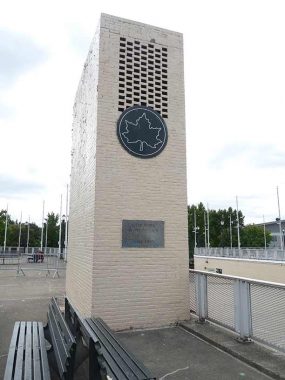
This isn’t going to be a comprehensive look at everything of interest in the park; it’s going to be a record of what I found on this particular walk. There are a pair of these brick structures on plazas flanking the ramp descending to the park from the boardwalk that appear to be vents. The plaques commemorate both the 1939-40 and 1964-65 Fairs.
Here’s a link to FNY’s World’s Fair pages…
I was too little at age eight to take a lot of photos at the Fair when I attended it from 1964-65, but my father obtained some photos in brilliant Kodachrome, seen here on this FNY page.
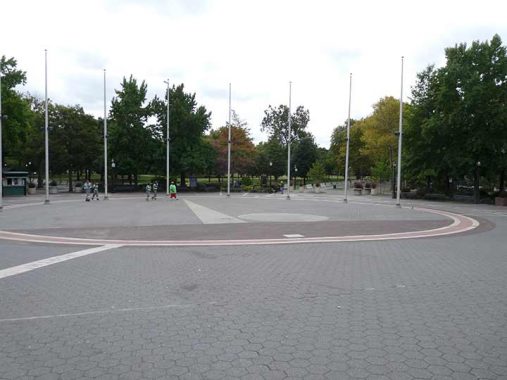
The 1939-40 Fair’s Trylon and Perisphere are set in gray tile in the entrance plaza, along with a ring of mosaics depicting past Fairs (see below). Earlier in the summer, I set off to find additional depictions of the T and P in Queens.

These concrete globes, depicting Earth, can be seen at Flushing Meadows park entrances as well as the parking lot adjacent to the Hall of Science. I had never taken much notice of them before, but they probably go back to the 1964 Fair.
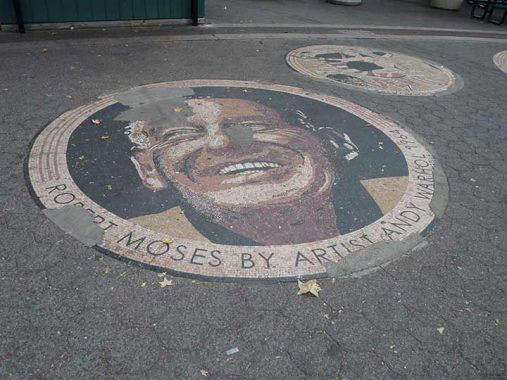
To this day, NYC Triboro Bridge and Tunnel Authority president Robert Moses can rile people up. Moses built most of NYC’s parkways and expressways, hundreds of apartments, and created hundreds of acres of parkland in NYC and suburbs. But he disdained mass transit…believing it attracted riffraff…and was ruthless in moving people out of the way who were in the paths of his roadways.
A number of contemporary artists were commissioned to create works that would appear on the exterior of the New York State Pavilion, among them Robert Indiana (of LOVE fame, who created an “EAT” neon billboard represented in mosaic here) and Andy Warhol, who chose to present the “13 Most Wanted” showing 13 criminals; Moses and other Fair officials vetoed it: among other reasons, most of the 13 were Italian. Warhol, working on a tight deadline, produced multiple portraits of a “furiously smiling” Moses, represented here in mosaic. Not surprisingly, Moses rejected that one too. Warhol covered the Moses portraits in gray/silver paint.
In recent years, Parks has failed to maintain the mosaics, patching worn-out sections in concrete and completely paving over two of them. At my request, Queens preservationist Michael Perlman sent a letter to Parks that reads thusly:
I hope you had an enjoyable summer. I am following up on my July 2022 request to have the mosaic installations restored at Dinkins Circle in Flushing Meadows Corona Park. At the time, numerous passionate residents echoed my request, in addition to the well-known and highly respected historian and author, Kevin Walsh of Forgotten New York. I have also learned that residents have been requesting their restoration for nearly 15 years. Two photos are attached.
A couple of the mosaic installations are completely cemented over, and several others have cement over portions of the mosaic artwork. Tiles are missing in both scenarios. Their damage is due to tossing salt to melt snow, transporting heavy equipment, and parking vehicles over these meaningful works of art.
These installations celebrate Robert Moses and our 1939 – 1940 and 1964 – 1965 World’s Fair history and architectural beauty, but they have been sadly transformed into eyesores due to their lack of maintenance. Nevertheless, we recognize their beauty, significance, and their great need for restoration.
Perhaps the Parks Department can also install a low-rise decorative fence that would not only safeguard the installations, but harmonize with their artistry, after conducting restoration work. You can also conduct an assessment to restore the mosaic installations in their current position. Another possibility is to elevate the mosaic installations parallel to the pavement and erect a base, or install them in a perpendicular manner. Adjacent informative plaques or signs can be installed, which would educate visitors and generate additional historic and civic pride.
Kevin Walsh and I propose obtaining an estimate from a private firm to restore them. If the Parks Department is not willing to secure funds, please allow the public, which heavily uses and benefits from our park daily, to coordinate a fundraiser and pursue the restoration of these commemorative mosaic relics.
I also welcome the further beautification of Flushing Meadows, which should include the preservation and utmost maintenance of all remaining World’s Fair relics, which are few and far between. World’s Fair related artifacts and buildings, including the symbolic Trylon and Perisphere monuments on brick facades, which knowingly exist in Forest Hills and Corona, also merit documentation and preservation with your help. It would be great if we can maintain a dialogue, with hopes of achieving a win-win on various fronts.
Thank you,
Michael Perlman
Rego-Forest Preservation Council
I set off on the park’s perimeter roads, all of which were once named. You can download a zoomable version of the World’s Fair map of 1964 here. Normally, I don’t photograph playgrounds when filled by kids, but this was a school day and Buzz Vollmer Playground was empty. It rates two separate signs, one in concrete on the pavement, and the other the standard sign Parks has been using for about a decade.
The avenue names are also shown on Open Street Map.
This playground honors Arnold H. “Buzz” Vollmer (1915-1995), a native New Yorker who became a leading designer of bridges, highways, and parks, working closely with Parks Commissioner Robert Moses (1888-1981) on some of New York’s biggest construction projects. [NYC Parks]

Flushing Meadows has an 18-hole golf course, albeit a small one. The ever changing face of Queens: Flushing Point Plaza, a development along the Van Wyck Expressway, a project under construction for about a decade, rises in the background.

The park paths are still vehicular roads used by park maintenance, and in spots are lit by regulation streetlamps, albeit without traditional bases and short-arm cobras. The rest of the park is lit by octagonal poles with post-top lamps; Type Bs, the usual park lamp, are nowhere to be found in Flushing Meadows.

The Flushing Meadows Corona Park Aquatics Center and Ice Rink. located at Flushing Meadows’.’ northeast sector, features an Olympics-sized swimming pool and was built in 2008 as the city prepared a bid to host the 2012 Olympics which were ultimately awarded to London. The roof is held up by cable stays, an interesting use of the technology other than to support bridge roadways. Parks has annoyed its patrons by closing it for repairs for lengthy stretches.

The unique Flushing Meadows-Corona Park signage uses different fonts than other fonts used by Parks or the Department of Transportation, which use Highway Gothic, Clearview, and Palatino (on the brown Parks signs, with the leaf). Other stanchions employ the classic Bookman font, but it’s the International Type Corporation Bookman developed in the 1970s with its large x-heights.
In 2022, Parks designed new signs for Flushing Meadows, but to date I have seen few of them, if any. I believe the design has been implemented at Van Cortlandt Park in the Bronx.
As mentioned previously the Flushing Meadows park paths once had names, such as Avenue of Progress, Avenue of Americas (not 6th Avenue); Avenue of Africa, and Promenade of Industry. Some are still marked by concrete tablets on the grass. More recently, they were given latters such as Avenue A, B, C, etc., but those signs also seem to have disappeared.
Fire protection in Flushing Meadows is handled by O’Brien and the newer model Dresser hydrants. While the standard color is black with silver tops, in the park, they’re yellow with black tops.
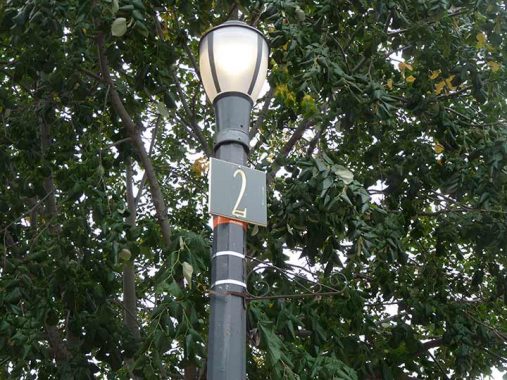
You will occasionally see a number mounted on a park lamp. As shown on the Google map of the park, the numbers refer to the park’s soccer fields, of which there are a total of seven.
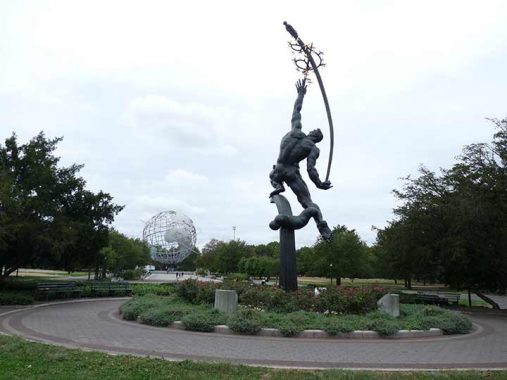
I hadn’t previously gotten Donald De Lue’s bronze “Rocket Thrower” from this angle, including the Unisphere. The statue sits amid a line of three now-disfunctional “Fountains of the Fairs.” Interestingly the two walkways flanking the fountains were called The Herbert Hoover and Dwight Eisenhower Promenades, ignoring the two Democratic presidents in between, FDR and Harry Truman.
“Rocket Thrower” stands in what was once known as the Court of the Astronauts, his back to the Fountain of the Planets and facing the Unisphere. It is one of a number of statues created for the Fair that had flight or space travel as a theme. The heroic-style sculpture depicts a giant throwing a rocket (in his right hand) through a network of stars (in his left). After the Fair opened in 1964, reviews of De Lue’s sculpture were decidedly mixed. NY Times art reviewer John Canaday called it a “most lamentable monster, making Walt Disney look like Leonardo Da Vinci.” Time, however, seems to treat massive public works with kindness.

The Column of Jerash, near the Rocket Thrower, is hidden amid a grove and is easy to overlook. Though I haven’t seen anything about this on the internets, its top has been removed and it’s obviously under repair.
It might be surprising to know that most of the world’s countries boycotted the ’64-65 Fair. Not because of any particular animus or grudge against the United States or New York City…it was just that there had already been a previous World’s Fair in Seattle in 1962, and most countries devoted their resources to that Fair. Nevertheless, 36 countries were represented, among them Jordan, whose young King Hussein presented this 30-foot, approximately 30-ton high marble column, built by the Romans during their occupation of the Holy Land in 120 A.D. in the city of Jerash. It was originally part of the temple of Artemis, goddess of the hunt.
According to the NYC Bureau of Parks, the Jordanian pavilion was a splendid “multi-peaked-and domed structure with an undulating roof, and surfaced in gold mosaic and shimmering blue glass.” The column is also marked by a tablet on the park path. It’s likely the second-oldest man-made object in a New York City park (after the Egyptian obelisk known as “Cleopatra’s Needle” in Central Park, which is fully 3500 years old).
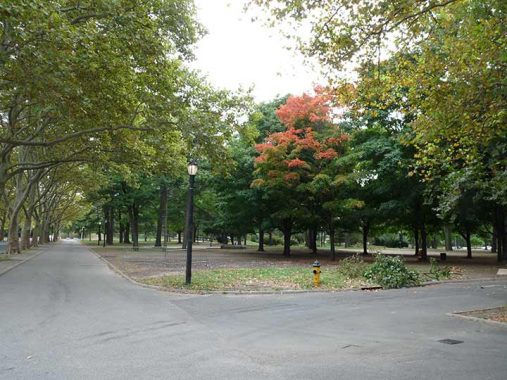
Some fall coloring has begin to appear in the park. This is not unusual, though peak widespread fall color does not fully flourish in NYC until late October into early November. The phenomenon occurs as leaves lose their chlorophyll as they prepare to drop and make way for spring buds.
Designed by Philip Johnson, the NY State Pavilion was among the most striking buildings at the Fair when it opened. It consists of the “Tent of Tomorrow” made up of 16 100-foot columns supporting a 50,000 sq. foot roof of multicolored panels (which was removed in the 1970s) as well as three towers, measuring 60, 150 and 226 feet tall. Fairgoers could ascend top the top of the towers via “Sky Streak” capsule elevators. Inside the pavilion, there was a scale model of the new St. Lawrence River hydroelectric plant, NY State industry information, artwork from the 19th-century Hudson River School, and portraits of NY State colonists.
The NY State Pavilion contained striking visuals both above and below. Texaco funded a giant map of New York State on the pavilion floor with 567 mosaic terrazo panels weighing about 400 lbs. each. Rand McNally supplied the topographic information, and Texaco furnished the location of each of its gas stations in the state. When the pavilion’s roof was removed due to its deterioration borne of general negligence, the Texaco map was open to the elements and it severely decayed, though some parts of it were removed and restored for a 2008 exhibit at QMA. For a briwf while, the Tent of Tomorrow hosted concerts, with the likes of Led Zeppelin and Carlos Santana. The “Sky Streak” elevators were removed several years ago when they became unstable.
There have been periodic attempts to encourage the pavilion’s restoration, with the light yellow color restored to the Tent’s rim and new lighting installed. A new restoration has been under way since 2023, with expected completion in 2025; currently, the towers are enshrouded in construction netting.
My wish list for the pavilion includes safe public access to the towers, which would restore the elevators, and a restoration of the New York State pavement map, this time with protections that would include protection from gouging and chipping and a surface from which paint and markers can be easily removed.
Teacher Matthew Silva and Salmaan Khan co-founded People for the Pavilion, a nonprofit advocacy organization dedicated to developing a vibrant community around the Pavilion, to raise awareness about the structure. This video highlights their efforts.
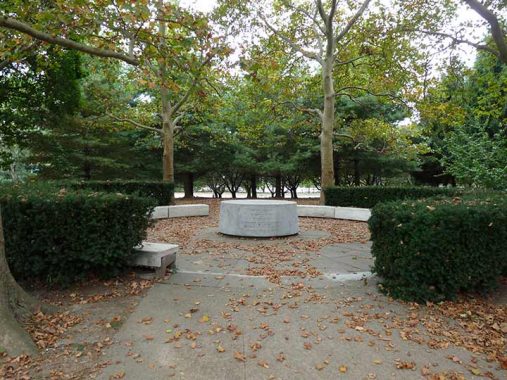
Don’t open till 6965. This little concrete slab, in its own little circular plaza next to the New York State Pavilion, is what remains of the 1939 Westinghouse Pavilion. The electrics giant featured a time capsule at its exhibit, including a slide rule, a woman’s hat, synthetic rubber, 10 million words on microfilm taken from books, magazines and newspapers and messages to the future from Albert Einstein and others. Westinghouse also built a new time capsule in 1964, including filtered cigarettes, a Beatles record, irradiated seeds, freeze-dried foods and a rechargeable flashlight: the cutting edge. The time capsule is supposed to last 5000 years. Well, it’s lasted over 60 years so it’s off to a pretty good start. The coasts, including NYC, are supposed to be under water within a few centuries, so the 66th Century version of Jacques Cousteau may be needed to recover it, if anyone remembers it’s there.

I like the park’s liberal use of conifers, which are actually used as curb trees near FNY HQ in Little Neck. Just looking at pines psychologically knocks down the temperatures 10 degrees on the hottest of days.
David’s Garden, near the Pavilion, was created to honor David Oats, the long-time editor of the Queens Tribune and a steadfast advocate for his beloved Flushing Meadows Corona Park. Oats, who helmed the Tribune over parts of three decades, grew up near the park, and as a 12-year-old snuck in during construction of the 1964-65 World’s Fair. He was brought in to see Parks’ “power broker” Robert Moses to get a stern talking to, but instead the two struck up a friendship centered on the park, and for the rest of his life, Oats was dedicated to honoring Moses by ensuring the proper upkeep of their beloved patch of green land.
Oats spent four decades advocating for the protection and improvement of the borough’s parks. He was founder and president of the Flushing Meadows Corona Park World’s Fair Association, with Moses as its first chair.
“David was the park’s keeper, watchdog, caretaker and conscience; prodding, urging, leading and demanding the borough and park powers-that-be care for the park with which David had a 40-plus year love affair,” wrote longtime friend and Queens Tribune publisher Michael Schenkler upon Oats’ death in 2008. In the editorial, Schenkler called for the creation of a memorial in the park to honor Oats. Negotiations between the borough and the Parks Department produced the final result – a garden between the Unisphere and the Queens Theatre.
What flowers are these? Comments are open. Not being a botanist, I can only tell you my favorite flowers are roses.
José de Rivera’s polished, twisting crescent Free Form, a short walk from Freedom of the Human Spirit, originally revolved on top of its base. De Rivera (1904-1985) created his statues with his own hands, forging and hammering his materials personally. As a result, he suffered a hearing loss. Beginning as a craftsman in Chicago, he worked as a pipefitter and die caster. Many of his works are steel or bronze bands twisted into 3-dimensional shapes, like Free Form.
In 1992-93, the sculpture was restored with funds from the De Rivera Foundation and the City, under the auspices of the Adopt-A-Monument Program, a joint venture of Parks, the Municipal Art Society, and the New York City Art Commission. At that time, the eroded pedestal was replaced with a more durable matching granite, the sculpture was polished, and the motor inside replaced. The surrounding area was landscaped with new lawns and shrubbery as part of the general improvements to the park’s core. [NYC Parks]
Though Free Form is supposed to revolve on its pedestal, and I’ve see it in action, it was still on this occasion, and I don’t know here the on-swicth is.
Nearby is the Yitzhak Rabin America-Israel Friendship Grove, named for the fifth Prime Minister of Israel, serving two terms in office, 1974–77 and 1992 until his assassination in 1995. He won the Nobel Peace Prize along with Palestinian leader Yasser Arafat and Rabin’s Foreign Minister at the time, Shimon Peres, in 1994.

For me the implementation of the Parks Flushing Meadows signage plan can’t come too soon as the signs are all over the place, design-wise. The Al Oerter on the sign is a multiple Olympic discus champion from Astoria, earning gold in 1956, 1960, 1964 and 1968.

About 30 years before the appearance of this Marshall Fredericks’ aquamarine sculpture near the Friendship Garden, Frederick MacMonnies’ Civic Virtue was banished from City Hall Park to the hinterlands of Kew Gardens; the statue’s depiction of the triumph of Civic Virtue over two writhing mermaids symbolizing corruption was deemed too risqué for City Hall. And, CV was banished again in the 2010s to Green-Wood Cemetery.
What a difference a few decades make … Freedom of the Human Spirit’s male and female figures are unabashedly disrobed. Fredericks wasn’t going for prurience. As he explained it, “I realized that great multitudes of people, of all ages, and from all walks of life would see this sculpture…I tried to design the work so that it was as free of the earth, as free in space as possible…the thought that we can free ourselves from earth, from the material forces which try to restrain and hamper us, is a happy, encouraging and inspiring one, and I sincerely hope that my work will convey this message.”
The statue originally stood in the 1964 Fair’s version of the Court of States. In 1996 it was renovated and resurfaced, and moved to its present position in front of the main entrance to the Arthur Ashe US Tennis Center and facing the Unisphere.

Exiting the park, I was reminded that vandals are ever ready with their relentless barrage and that Parks needs to be vigilant.
As I mentioned, I’m a fan of the Mets-Willets Points new year-round status. FNY has a feature on the station with vintage photos. However, the station is unusable for people with disabilities as there is no elevator or escalator, and the steps are quite steep; when I have a bad back, downhills and steep downward steps are difficult. Years ago, when there was a (mostly ill-advised) plan to run the AirTrain to LaGuardia Airport from Mets-Willets Point, station renovations including escalators and elevators were part of the plan. When Governor Kathy Hochul assumed office after Cuomo’s resignation, she vetoed the plan.
A new plan by Mets owner Steve Cohen proposes a casino and soccer stadium for the no-man’s land east of Citifield home to its vestiges of auto repair shops. That plan would also make the station ADA compliant. However, some local officials do not like the project at its current scope and any improvements are years away.
As always, “comment…as you see fit.” I earn a small payment when you click on any ad on the site. Take a look at the new JOBS link in the red toolbar at the top of the page on the desktop version, as I also get a small payment when you view a job via that link.
9/29/24

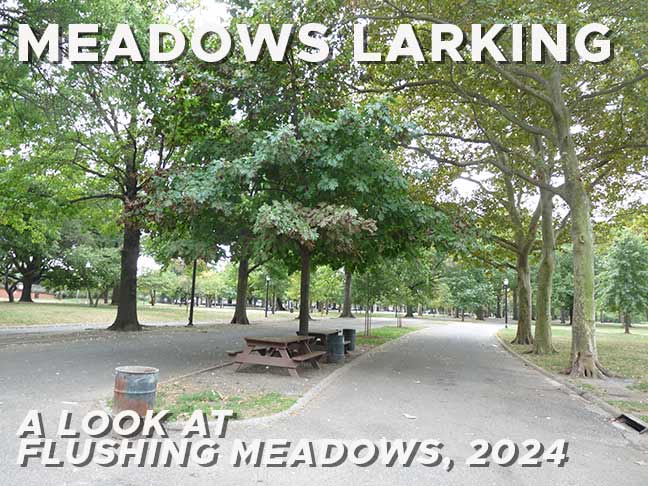
8 comments
“Time, however, seems to treat massive public works with kindness….”
Reminds me of John Huston in the film Chinatown:
“Politicians, ugly buildings, and whores all get respectable if they last long enough.”
I have the original on-paper World’s Fair maps. There was one for 1964 and an updated one for 1965. As for the NYS pavilion, I was very impressed by the giant Texaco map.
It is oddly comforting to note that the Earthlings of 6965 will recognize filtered cigarettes as a high point of the 20th Century.
Casey managed the Mets from their inception in 1962 until he broke his hip in the summer of 1965. Steve Cohen’s planned casino would be built over the current parking lot on the west side of CitiField. There are legal and political headwinds as this would necessitate using city parkland. The soccer stadium is directly east of CitiField and is under construction along with apartment buildings, etc.
Yes, I was referring to his time in Flushing, 1964-1965.
The NY Times did a story on the demolition of the World’s Fair after it closed.
Who can ever forget that photo of a construction worker riding high on a
Sinclair Oil Dino as a crane rips its head off.
The “new” LaGuardia Airport is world class. A direct rail link from LaGuardia to Manhattan would have put it on par with the airports of most major world cities. The proposed Air Train was the best of several “not perfect” options. The others were not viable at all. We are left with free bus service to the subway at Jackson Heights or the LIRR in Woodside. These busses must compete with cars and taxis on roads within the airport and then also with trucks and other busses on the city streets. In addition to traffic jams, they are also vulnerable to snow and rain driving conditions. Passengers on the Air Train would have boarded them inside the terminals and had a reasonable transfer to the LIRR or #7. While the Air Train would not have been perfect, what we have now is a poor substitute.
The new Laguardia airport is pretty and comfortable inside, but it is overbuilt with acres of wasted space and endless corridors, basically an Ozymandian vanity project for Andy Cuomo. What the airport really needed was an additional runway to ease take-off/landing delays, which is what travelers want more than spiffy overpriced food spots.